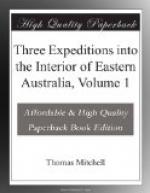August 17.
Nineteen of our bullocks had strayed during the night, but were found about seven miles back, in a scrub near the Bogan. We did not therefore start until ten o’clock, but were able nevertheless to cross the Pink hills, and reach our ground of May 19.
DISCOVERY OF THE CAPER-TREE.
Today I fell in with a tree of which I saw but a single specimen during my former journey,* and I had observed only a sickly one before during this expedition. It bore a yellow flower, and fruit resembling a small pomegranate, on a hooked stalk. I had unfortunately omitted to gather specimens of it when seen by me in flower in 1831; and now I could not procure any of the seeds, every rind being hollow, and the interior destroyed apparently by insects. I considered this a very remarkable tree as well from its rare occurrence as on account of its fruit, of which the natives appear to make some use.
(Footnote. See above.)
The Pink hills, as I have already mentioned, consist of the diluvial gravel, and their position at the point separating the tributary basin of the Macquarie and Bogan from the channel of the Darling is just where such a deposit might be produced.
August 18.
I was more successful in my search this morning for seeds of the fruit above-mentioned; and I was surprised to find many specimens of the tree in the scrub through which we had previously passed without observing them. On one plant we found some fruit apparently full-grown, but not ripe; and on others perfect specimens of the last year’s crop, including, of course, the seeds. The fruit resembles a small lemon but has within small nuts or stones enveloped in a soft pulp, and the whole has an agreeable perfume. We also found some specimens of the flower, rather faded.* We reached our old encampment of May 18 by three o’clock.
(Footnote. My friend Dr. Lindley considers this one of the most interesting plants brought home by me, and has described it as follows:
Capparis Mitchellii, Lindley manuscripts; stipulis spinosis, foliis obovatis supra glabris, pedunculis floris solitariis clavatis foliis brevioribus, fructu sphaerico tomentoso. A fine specimen of Capparis related to C. sandwichiana.)
August 19.
When all were ready to start it was discovered that one bullock was missing; the two men who had been in charge of the cattle all night were sent in search of it, while the party proceeded towards our former camp of May 17. As our route between these camps traversed the great bend where the course of the Bogan changes from north to west-north-west I was enabled to cut off four miles by travelling North 145 degrees East a part of the way.
THE KANGAROOS AND EMUS DRIVEN AWAY BY THE NATIVES.
We crossed some undulating ground with an open forest upon it in which we killed two large kangaroos. We supposed, on account of this success, that we had outwitted the blacks by our cross course; for we had reason to suspect that they proceeded ahead of us along our old track and drove off the emu and kangaroo as we seldom saw either. We however surprised two natives cutting away at an opossum’s hole in a tree at some distance to our left; and on seeing us they made off with great speed towards the northern bend of the river and our former route.




